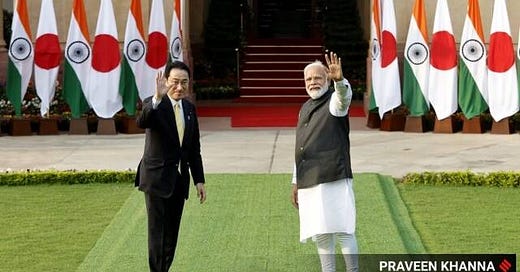The Jugaad-Shokunin dichotomy
Why the India-Japan relationship remains hamstrung despite a perfect fit on paper
Konnichiwa Global Jigsaw friends,
Hope everyone had a lovely Easter week. We spent a few days on the island of Mallorca, about which, more soon. I am just back home from my penultimate chemo (yay!) and in dire need of a nap, so getting straight to today’s post.
I hope you enjoy it. If so, please share it and do upgrade to a paid subscription. That will enable you to access the full text of this, and other, posts. I would love to have you become an integral part of this global jigsaw community.
In theory, there are few nations that make a better economic and strategic fit than Quad-partners and civilizational cousins, India and Japan. The former is fast-growing and demographically effervescent, while the latter remains in a holding pattern economically and faces a labour crunch. India needs technical expertise and investments to develop its infrastructure. Japan has capital to spare and know-how to share.
Some of these synergies were on display when Japanese Prime Minister Fumio Kishida visited India last month. But the real common denominator that has the archipelago and the subcontinent on the same strategic page is their mutual wariness of China’s creeping sway over Asia.
Mr. Kishida’s announcement of over $75 billion worth of infrastructure and security assistance for the Indo-Pacific, through private investments and yen loans, was made with an eye firmly on containing the influence of the Chinese Mainland in the region. The Japanese political class has for many years been keenly aware of the importance of decoupling its economy from China’s, with India being seen as a potential replacement.
Yet, despite all these favourable factors, the Indo-Japanese bilateral relationship remains strangely hamstrung. Economic ties, in particular, do not match the strategic closeness that New Delhi and Tokyo have developed. They are underwhelming, not only in relation to their potential, but also when compared to the bilateral equation that each nation has with their common bête noir: China.
Kishida and Modi in Delhi in March 2023. Photo credit: Praveen Khanna for the Indian Express
Japan-India two-way trade stood at $20.57bn in 2021-22, a fraction of the heft of the $371 billion that Japan-China traded in 2021. In fact, China is Japan's largest trade partner. Even India’s trade with China (which was at an all-time high of $135.98 bn in 2022) dwarves its equivalent with Japan. The share of India-Japan trade in Japan’s total trade basket is barely 1% and it is a little over 2% of India’s trade with the rest of the world. Japanese investments in China are similarly multiple times higher than equivalent investments in India.
The most high-profile Japanese investment in India, is the country’s first high-speed rail corridor, from Mumbai to Ahmedabad, that is being developed using Japanese technology and financing. It was inaugurated in 2017, with Japan providing 80% of the funding through a soft loan with an interest rate of just 0.1%. Somewhat predictably, land acquisition delays have significantly slowed implementation. The project was slated for completion in 2023, but today large swathes of the 508 km corridor remain unbuilt.
In many ways this project is the bellwether of how the Japan-India relationship might fare going forward. If it succeeded, on time and according to plan, it would pave the way for more Japanese investment in critical Indian infrastructure, boosting trust and facilitating cooperation in third countries as well. But if it, as it in matter of fact has, hit snags the deal would once again highlight a cold truth: the yawning gap between the theoretical fit and practical dissonance in the Japan-India economic relationship.
This gap cannot wholly be explained by the usual suspects that plague foreign investors in Indian ventures. Corruption, inadequate infrastructure, complex tax regulations and land acquisition problems are certainly significant challenges, but they do not constitute the whole, troubled, picture.
The greatest challenge keeping India and Japan apart is a cultural incompatibility that I sum up as the jugaad-shokunin dichotomy.




